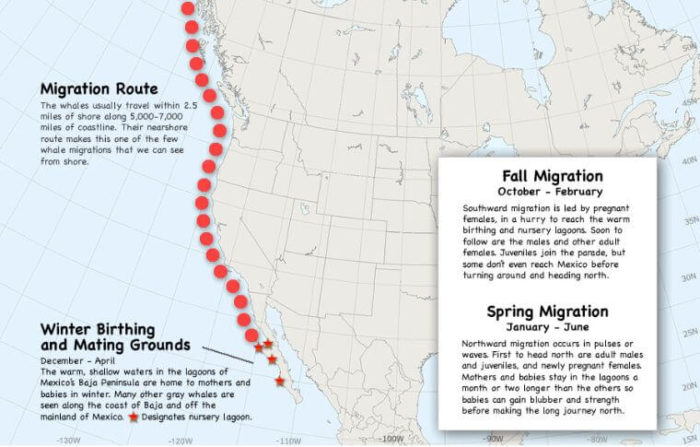 Gray Whales (Eschrichtius robustus) have the longest known migration of any mammal on the planet. They spend their winters mating and giving birth to young in the warm waters of the Baja peninsula and summers feeding in the Bering, Chuckchi, and Beaufort Seas of the Arctic. Most whales travel at least 10,000 miles round trip, although some do not travel the entire migration route and stay feeding further south during the summer. Along this migration, many whales can be seen along the West Coast, because they only travel within 3 miles of the shore.
Gray Whales (Eschrichtius robustus) have the longest known migration of any mammal on the planet. They spend their winters mating and giving birth to young in the warm waters of the Baja peninsula and summers feeding in the Bering, Chuckchi, and Beaufort Seas of the Arctic. Most whales travel at least 10,000 miles round trip, although some do not travel the entire migration route and stay feeding further south during the summer. Along this migration, many whales can be seen along the West Coast, because they only travel within 3 miles of the shore.
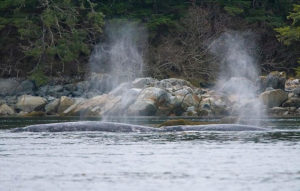 At birth, calves are around 16 ft long and 2000 lbs. The mothers and calves are the last to leave Mexico on the migration because they will not begin the long journey until calves are strong and have gained enough body fat. During the migration, transient orcas are the biggest concern, and mothers must fiercely protect their calves from these predators.
At birth, calves are around 16 ft long and 2000 lbs. The mothers and calves are the last to leave Mexico on the migration because they will not begin the long journey until calves are strong and have gained enough body fat. During the migration, transient orcas are the biggest concern, and mothers must fiercely protect their calves from these predators.
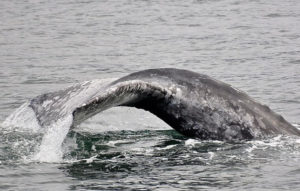 We are lucky to be able to watch these whales during a period of the spring season in Sitka, as they are passing through the area. We often see them feeding in shallow waters, sometimes right up against rocks. Like humpback whales, gray whales have baleen plates they use to filter feed, but you won’t see them lunge feeding. Instead, they are bottom feeders. Gray whales are the only species of whale that strain sediments on the bottom of the ocean, sifting out small mollusks, worms, and amphipods, isopods, mysids, which are all very small crustaceans. They also like feeding on herring eggs laid in the spring in shallow grass beds.
We are lucky to be able to watch these whales during a period of the spring season in Sitka, as they are passing through the area. We often see them feeding in shallow waters, sometimes right up against rocks. Like humpback whales, gray whales have baleen plates they use to filter feed, but you won’t see them lunge feeding. Instead, they are bottom feeders. Gray whales are the only species of whale that strain sediments on the bottom of the ocean, sifting out small mollusks, worms, and amphipods, isopods, mysids, which are all very small crustaceans. They also like feeding on herring eggs laid in the spring in shallow grass beds.
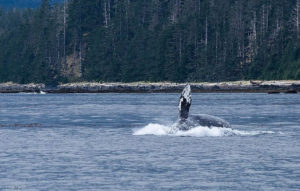 Other than feeding, gray whales also exhibit a variety of other unusual and unique behaviors. It is not as common to see gray whale flukes in a diving behavior, such as seen when watching humpbacks. Usually, gray whales don’t need to dive very deep because of how shallow they are feeding. If you do see the flukes, it is often due to the whale making sharp turns while feeding, causing the flukes to break the surface.
Other than feeding, gray whales also exhibit a variety of other unusual and unique behaviors. It is not as common to see gray whale flukes in a diving behavior, such as seen when watching humpbacks. Usually, gray whales don’t need to dive very deep because of how shallow they are feeding. If you do see the flukes, it is often due to the whale making sharp turns while feeding, causing the flukes to break the surface.
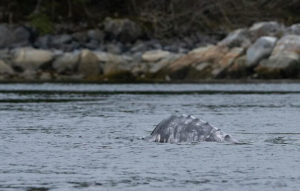 Gray whales are not known to be very acrobatic like humpback whales. Last year, however, we were fortunate to see a baby gray whale breaching! These whales are very quiet on the surface and sometimes look so similar to the rocks they are seen feeding by that are referred to as “breathing rocks.” They do not have a dorsal fin that easily distinguishes them. Instead, their backs have a small hump followed by a series of ridges as seen in the photo below. Their coloring is also unique, a splotchy and mottled pattern of various grays. Bodies are covered in barnacles, whale lice, and scars from scraping the ocean floor. If you tour with us in the spring/early summer, we hope you get a chance to view the unique behaviors of these interesting creatures before they continue north!
Gray whales are not known to be very acrobatic like humpback whales. Last year, however, we were fortunate to see a baby gray whale breaching! These whales are very quiet on the surface and sometimes look so similar to the rocks they are seen feeding by that are referred to as “breathing rocks.” They do not have a dorsal fin that easily distinguishes them. Instead, their backs have a small hump followed by a series of ridges as seen in the photo below. Their coloring is also unique, a splotchy and mottled pattern of various grays. Bodies are covered in barnacles, whale lice, and scars from scraping the ocean floor. If you tour with us in the spring/early summer, we hope you get a chance to view the unique behaviors of these interesting creatures before they continue north!
#whales #whalewatching #whalephotography #hydrophone #sitkaalaska #bubblenetfeeding #wildlifetour